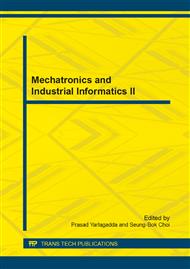[1]
Jianli Yu, Kroumov V: The Method of Robot's 3D Path Planning, Chinese Patent, 200710193060. x (In Chinese).
Google Scholar
[2]
Jianli Yu, Siya chen, Zengqing Sun, Kroumov V: Central South University(Natural science), Vol. 40(2009), pp.471-477 (In Chinese).
Google Scholar
[3]
Yong Chen, Dong Wang, Ge Chen: A 3D Fast Path Planning with Virtual Scene Base on Rubber Band Algorithm, Chinese Patent, 200710094209. 9 (In Chinese).
Google Scholar
[4]
Kuimin Wang, Ye Hong, Xingqian Bian, Zheping Yan: Wuhan University of Technology ( Transportation Sience & Engineering), Vol. 32(2008), pp.1002-1004+1020. (In Chinese).
Google Scholar
[5]
Haifei Si, Zhong Yang, Jun Wang: Mechanical and Electrical Engineering , Vol. 28(2011), pp.16-20+37. (In Chinese).
Google Scholar
[6]
Yongbin Zhang: The UAV formations Research based on probability calculations and state predicted, Dilian University of Technology, 2013 (In Chinese).
Google Scholar
[7]
Shaobao Li: Multi-Target Flocking Control and Distributed Formation Topology Optimizing for Multi-Agent System, Yanshan University, 2012 (In Chinese).
Google Scholar
[8]
Chengzhi Li: Research on surveillance using UAV Based on Collaborative Technology, University of electronic science and technology of China (In Chinese).
Google Scholar
[9]
Xing Liu, Sentang Wu, Xiaomin Mu, Chen Peng, Jiqiang Tang: Journal of System Simulation, Vol. 19(2008), pp.5075-5080+5085 (In Chinese).
Google Scholar
[10]
Yancai Chen: Research on Distributed Cooperative Control for Swarm UAVs, Nanjing University of Aeronautics and Astronautics, 2011 (In Chinese).
Google Scholar
[11]
Luhua Zhao, Puyun Wang, Xiang Chen, Wei Zhou: Electronics Ptics & Control, Vol. 08(2011). pp.34-39 (In Chinese).
Google Scholar
[12]
Xia Chen, Jing Zhang: The Three-Dimension Path Planning of UAV Based on Improved Artificial Potential Field in Dynamic Environment, Intelligent Human-Machine Systems and Cybernetics (IHMSC), 2013 5th International Conference on, Vol. 2(2013).
DOI: 10.1109/ihmsc.2013.181
Google Scholar
[13]
Xiaomin Tong, Yanning Zhang, Tao Yang: Artificial Potential Field Based Cooperative Particle Filter for Multi-View Multi-Object Tracking, Virtual Reality and Visualization (ICVRV), 2013 International Conference on, pp.74-80.
DOI: 10.1109/icvrv.2013.20
Google Scholar
[14]
Gao Yun; Wei Zhiqiang; Gong Feixiang; Yin Bo; Ji Xiaopeng: Dynamic Path Planning for Underwater Vehicles Based on Modified Artificial Potential Field Method, Digital Manufacturing and Automation (ICDMA), 2013 Fourth International Conference on, pp.518-521.
DOI: 10.1109/icdma.2013.122
Google Scholar
[15]
Mei Wang; Zhiyong Su; Dawei Tu; Xichang Lu: A hybrid algorithm based on Artificial Potential Field and BUG for path planning of mobile robot, Measurement, Information and Control (ICMIC), 2013 International Conference on, pp.1393-1398.
DOI: 10.1109/mic.2013.6758219
Google Scholar
[16]
Xiaoming Wang; Wenfeng Li; Wei Song; Wentao Dong: Connectivity Controlling of Multi-robot by Combining Artificial Potential Field with a Virtual Leader, Systems, Man, and Cybernetics (SMC), 2013 IEEE International Conference on, pp.374-377.
DOI: 10.1109/smc.2013.70
Google Scholar
[17]
Macktoobian, M.: Smart navigation of autonomous mobile robots by Time-Variant Artificial Potential Fields: A fuzzy approach, Fuzzy Systems (IFSC), 2013 13th Iranian Conference on, pp.1-6.
DOI: 10.1109/ifsc.2013.6675610
Google Scholar


